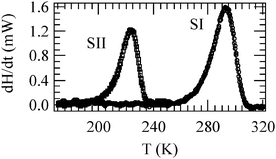Abstract of Publication No. 507
 Dominik Schaniel, Theo Woike, Bernard Delley, Colette Boskovic, Daniel Biner, Karl W. Krämer and Hans-Ueli Güdel
Dominik Schaniel, Theo Woike, Bernard Delley, Colette Boskovic, Daniel Biner, Karl W. Krämer and Hans-Ueli Güdel
Long-lived light-induced metastable states in trans-[Ru(NH3)4(H2O)NO]Cl3·H2O
and related compounds
Phys. Chem. Chem. Phys. 7, 1164-1170 (2005)
![]()
![]()
Abstract:
The existence of two light-induced long-lived metastable states
SI, SII in irradiated
trans-[Ru(NH3)4(H2O)NO]Cl3·H2O
and trans-[Ru(NH3)4(OH)NO]Cl2 is
revealed by differential scanning calorimetry measurements and calculations
based on density functional theory. Irradiation with light in the blue spectral
range leads to the population of SI, while SII can be obtained by transferring
SI into SII with irradiation of light in the near infrared spectral range. The
population and transfer of the metastable states is described by exponential
functions and the thermal decays are evaluated according to Arrhenius' law, yielding activation energies
of EA(SI)= 0.95(3) eV, EA(SII)= 0.69(3) eV
and frequency factors of Z(SI)= 2 × 1014 s–1,
Z(SII)= 3 × 1013 s–1 for
trans-[Ru(NH3)4(H2O)NO]Cl3·H2O,
while EA(SI)= 0.91(3) eV, EA(SII)= 0.60(3)
eV, Z(SI)= 6 × 1014 s–1, Z(SII)= 1 ×
1013 s–1 for
trans-[Ru(NH3)4(OH)NO]Cl2. The
observations are compared with the ground state potential surface calculated by
density functional theory, where the metastable states correspond to a
side-on bonded (SII) and isonitrosyl(SI) configuration of the NO
ligand. The calculations provide the energetic minima of the ground state and
the metastable states SI and SII as well as the saddle points along the reaction
coordinate Q, which corresponds roughly to a rotation of the NO ligand by
about 90°(SII) and 180°(SI), and therefore allows for the comparison between
observed and calculated activation energies.